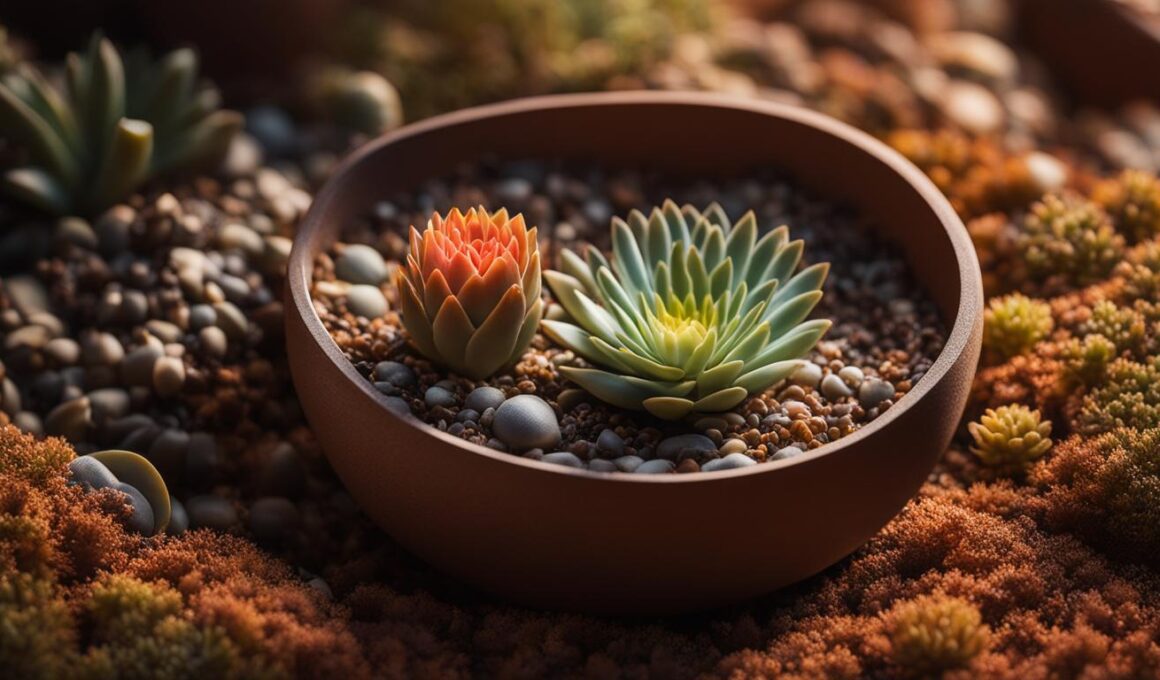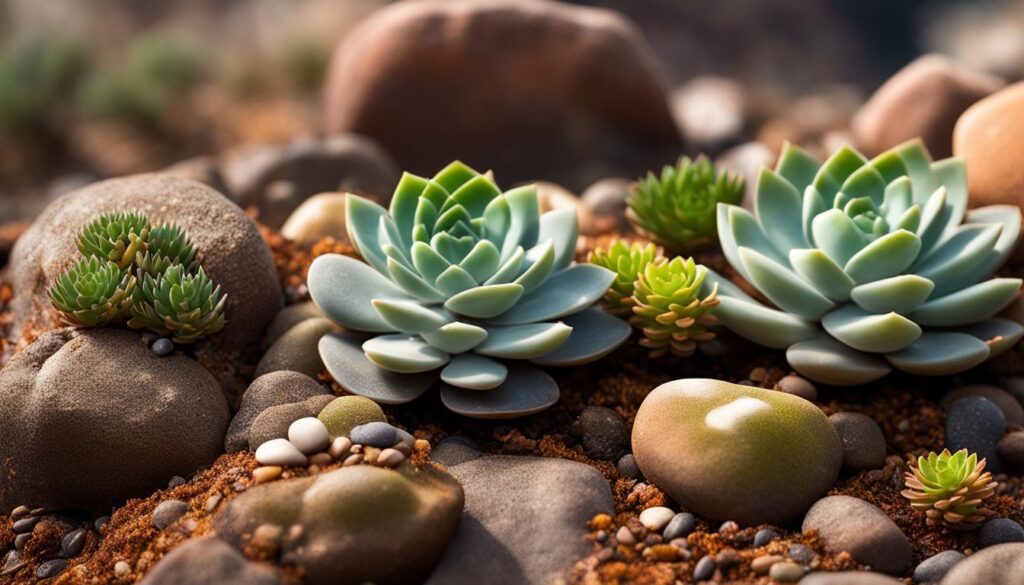If you’re a plant enthusiast, you may have come across Lithops, also known as living stones. These unique succulent plants undergo a fascinating natural process of splitting as part of their growth cycle. But how long does it actually take for Lithops to split?
The time it takes for Lithops to split can vary depending on environmental conditions, but on average, it takes about a month or two. This splitting allows new leaves to emerge and replaces the old growth, ensuring the plant’s vitality and continued propagation.
During the splitting process, it is crucial to provide proper care. One important aspect is to avoid watering the plant, as it can disrupt the development of new leaves. By understanding the right conditions and techniques, you can ensure the health and longevity of your Lithops plant collection.
Key Takeaways
- Lithops undergo a natural process of splitting as part of their growth cycle.
- The average time for Lithops to split is around a month or two.
- Avoid watering Lithops during the splitting process to facilitate the development of new leaves.
- Proper care and environmental conditions are crucial for the health and vitality of Lithops.
- Lithops can be successfully propagated and integrated into your plant collection with appropriate care.
Characteristics of Lithops
When it comes to succulent plants, Lithops stand out with their unique appearance. These plants, also known as living stones, have leaves that resemble stones. The two large, fleshy leaves fuse together at the soil level, creating a carrot-like root structure. This adaptation allows Lithops to blend with their surroundings, providing camouflage and protection from predators. The top of the plant can display a variety of patterns and colors, making each Lithops specimen truly unique.
Lithops have a slow growth cycle, and when they mature, they undergo a process of splitting. This splitting is a natural and expected part of their life cycle. As the plant splits, new leaves emerge to replace the old growth. It’s a remarkable sight to witness the transformation of these stone-like plants into vibrant, living organisms. The splitting process can take about a month or two, depending on the environmental conditions.
Throughout their growth cycle, Lithops require proper care to ensure their health and vitality. Providing them with adequate light, well-drained soil, and appropriate watering is essential. These succulent plants thrive in about 4 to 5 hours of direct sunlight in the early morning and partial shade in the afternoon. Overwatering and inadequate light are the most common causes of Lithops’ demise, so it’s crucial to strike the right balance in caring for these fascinating plants.
Characteristics of Lithops
| Appearance | Growth Cycle |
|---|---|
| Lithops have leaves that resemble stones and provide camouflage. | They have a slow growth cycle and undergo a process of splitting. |
| The top of the plant may display various patterns and colors. | Lithops split to make way for new growth. |
| This splitting is a natural and expected part of their life cycle. |
Proper Care During Lithops Splitting
Lithops, also known as living stones, undergo a natural process of splitting as part of their growth cycle. This splitting allows new leaves to emerge and replaces old growth. During this period, it is crucial to provide proper care to ensure the health and vitality of the plant.
One important aspect of caring for Lithops during the splitting process is to avoid watering the plant. Watering can interfere with the development of new leaves and disrupt the natural splitting. It is recommended to withhold water for about a month or two until the splitting is complete.
In addition to proper watering, environmental conditions also play a significant role in the splitting of Lithops. These plants require about 4 to 5 hours of direct sunlight in the early morning and partial shade in the afternoon. Providing the right amount and quality of light will support the splitting process and overall growth of the plant.
Furthermore, it is essential to ensure well-drained soil for Lithops. These plants are susceptible to root rot, so it’s crucial to avoid overwatering and provide a suitable soil mix that allows excess moisture to drain away. Inadequate light and overwatering are the most common causes of Lithops’ demise, so maintaining the right environmental conditions is key to their care.
| Care During Lithops Splitting | Summary |
|---|---|
| Avoid watering the plant | Interferes with leaf development and splitting |
| Provide proper light conditions | 4 to 5 hours of direct sunlight in the morning and partial shade in the afternoon |
| Ensure well-drained soil | Avoid overwatering and provide a suitable soil mix |
Watering Lithops During Different Seasons
Lithops, being succulent plants, have unique watering requirements that vary with the changing seasons. Understanding when and how to water your Lithops is crucial for their overall health and growth cycle. Below, you will find detailed guidance on watering Lithops during different seasons:
Summer:
In summer, Lithops enter a dormant phase and do not require regular watering. During this time, it is important to refrain from watering your plants as excess moisture can lead to root rot.
Autumn:
In autumn, Lithops resume their growth cycle, and watering should only be done when the soil has completely dried out since the last watering session. This ensures that the plants receive adequate hydration without risking waterlogged roots.
Winter:
During winter, Lithops draw water from their old leaves and do not typically require additional watering. It is essential to avoid watering during this time as it can lead to overhydration and potentially harm the plants.
Spring:
In spring, light watering can be introduced to aid in the start of new growth. However, it is crucial to closely monitor the soil moisture and avoid overwatering, as this can still pose a risk to Lithops’ health. Allow the soil to dry out between watering sessions.
By understanding the watering needs of Lithops during different seasons, you can provide the appropriate care and support for their growth cycle. Remember to always observe the condition of the soil and adjust your watering frequency accordingly to ensure the well-being of your Lithops.
Watering Guidelines for Lithops During Different Seasons
| Season | Watering Frequency |
|---|---|
| Summer | No watering required; plants are dormant |
| Autumn | Water when soil has completely dried out since the last watering session |
| Winter | Avoid watering; plants draw water from old leaves |
| Spring | Light watering allowed; monitor soil moisture and avoid overwatering |
Conclusion
In conclusion, Lithops are fascinating succulent plants that undergo a natural process of splitting as part of their growth cycle. This splitting allows for new leaves to emerge and replaces old growth. During this time, it is crucial to provide proper care to ensure the health and vitality of the plant.
When it comes to caring for Lithops during the splitting process, it is important to avoid watering the plant. Watering during this time can disrupt the development of new leaves and hinder the splitting process. It is also essential to consider environmental conditions such as light and temperature, as they have an impact on the splitting of Lithops.
Additionally, proper care for Lithops extends beyond the splitting process. Providing adequate light, well-drained soil, and appropriate watering during different seasons is essential for the plant’s overall well-being. With the right care, Lithops can be successfully propagated and integrated into your plant collection.
So, if you’re looking to add a unique and captivating plant to your collection, consider Lithops. With their distinctive appearance and intriguing growth cycle, they are sure to bring joy and wonder into your home or garden.
FAQ
How long does it take for Lithops to split?
The time it takes for Lithops to split varies, but generally, it takes about a month or two.
What are the characteristics of Lithops?
Lithops are succulent plants that have a unique appearance resembling stones. They have two large, fleshy, translucent leaves that fuse together at the soil level, forming a carrot-like root structure. The top of the plant may display various patterns and colors. Lithops undergo a slow growth cycle and will split open to make way for new growth when they mature.
What care is required during the splitting process of Lithops?
During the splitting process of Lithops, it is important to avoid watering the plant, as this can disrupt the development of new leaves. Environmental conditions, such as light and temperature, also play a role in the splitting process. Lithops require about 4 to 5 hours of direct sunlight in the early morning and partial shade in the afternoon. It is important to provide well-drained soil and avoid overwatering, as inadequate light and overwatering are the most common causes of Lithops’ demise.
How should Lithops be watered during different seasons?
In summer, Lithops are dormant and should not be watered. In autumn, they resume growth, and watering should be done when the soil has dried out since the last irrigation session. In winter, Lithops draw water from the old leaves, so watering is not necessary. In spring, light watering can be done to aid in the start of new growth. It is crucial to observe the soil moisture and adjust the watering frequency accordingly to ensure the health and vitality of the plant during different seasons.
What Factors Influence the Splitting Process of Lithops?
When lithops split, factors such as temperature, light, and water greatly influence the process. A sudden increase in temperature and prolonged exposure to direct sunlight can trigger splitting. Conversely, overwatering can delay or stunt the splitting process. Proper care and monitoring are crucial for the successful splitting of lithops.











